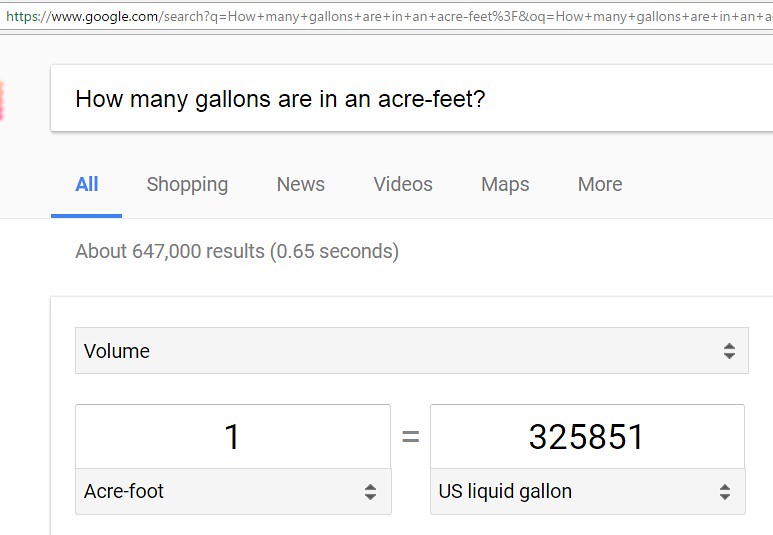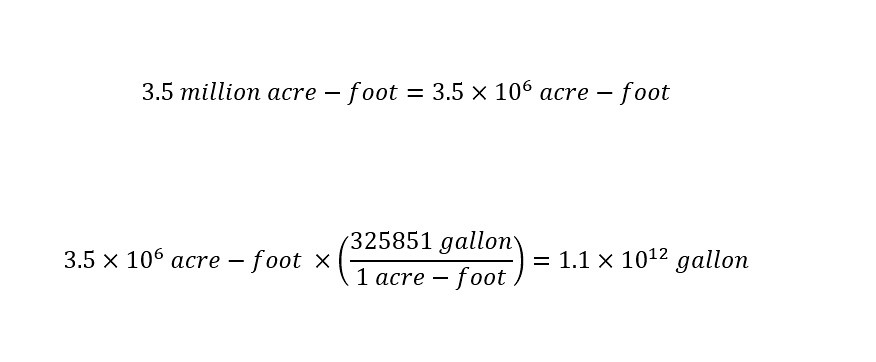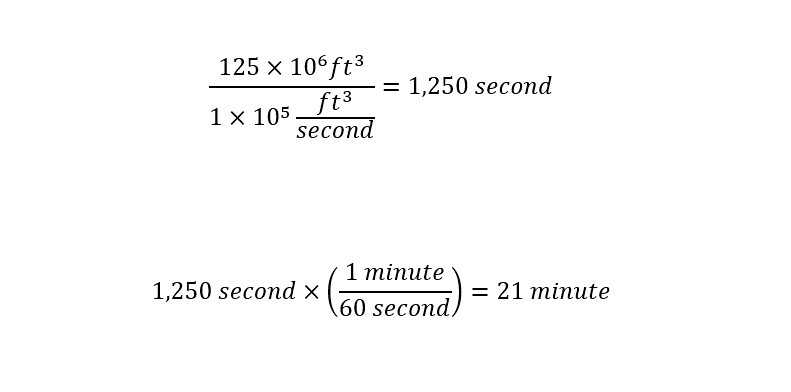The original tweet can be found here. Considering that much water flowing from the overflow, the following two questions emerge in my mind:
What is the total capacity of the dam (for Lake Oroville) and the flow rate?
Furthermore, to understand the magnitude of the evacuation, how can a person make sense of the flow rate?
In the post below, I answer the questions stated above and shed light on this terrible disaster.
Total Volume Of Lake Oroville
Lake Oroville was designed to originally serve as a water storage facility. The lake impedes the Feather river with the Oroville Dam as shown below:
Source: California Department of Water Resources
The total capacity of the lake is 3.5 million acre-feet of water -- Wow! Lake Oroville has a surface area of 25 square miles. The following question arises:
How does a person grasp an enormous volume of water like Lake Oroville?
In order to put that large of a volume into perspective, a 'metric' must be used for comparison. In the past posts on this site, I have used the "World's Largest Swimming Pool" located in Chile. According to the "Wikipedia" page, the total volume of the swimming pool shown below is 66 million gallons of water.
Source: Huffington Post
To start an analysis of placing a large volume like Lake Oroville into perspective, the 'units' must be the same. The units of measurement for the volume of the Lake Oroville were 'acre-feet'. Whereas the volume of the "World's Largest Swimming Pool" are in 'gallons.' In order to divide the two, a decision needs to be made.
Either, a unit conversion is done on the total volume of the lake from units of 'acre-feet' to 'gallons' or vice versa. In this case, the former route is easiest. The conversion factor from 'acre-feet' to 'gallons' will need to be determined. I decided to type into the Google search engine the following: How many gallons are in an acre-feet? The result is shown below:
Using the conversion factor above, the unit conversion from 'acre-foot' to 'gallon' is possible as shown below:
In the first line above, the total water volume of the Lake Oroville is converted from shorthand notation (3.5 million acre-foot) to scientific notation. The second line shows the unit conversion from units of 'acre-foot' to 'gallon'. Now, the units in each value are the same. That is, both the value of the total capacity of water held in Lake Oroville and the value of the "World's Largest Swimming Pool" are both expressed in units of 'gallon'.
The next step to determine the number of swimming pools ("World's Largest Swimming Pool") that can be filled with the total volume of water in Lake Oroville. Last, take the total volume of water (held in Lake Oroville) and divide by the metric -- swimming pool volume to yield the total number of swimming pools which could be filled as shown below:
The total number of swimming pools ("World's Largest Swimming Pool") which could be filled with the total volume of Lake Oroville is 17,000. Wow! That is a large amount of water.
Running through the dimensional analysis above is helpful in casting the volume of water held in Lake Oroville into a perspective which can be extended to the current disaster. The spillway which serves as a relief for the Oroville Dam has a broken wall (30 feet high) which busted and released an enormous wall of water out of the side. The disaster is shown in the picture above.
The result of the break was a release of an enormous amount of water which flowed into the surrounding community and resulted in the displacement of over 180,000 residents. In order to contain the Oroville Dam, engineers would like to lower the reservoir by nearly 50 feet of water.
In the section below, I take you through the calculation to figure out the amount of water contained in 50 feet of the Oroville reservoir. The result is surprising given such a large flow rate. This analysis shows the depth and enormity of the disaster to the community surrounding the Oroville reservoir.
Overflow Of The Dam
As I showed above, recently, there was a recent overflow of the Oroville dam. In a recent article by the "Los Angeles Times" titled "Biggest fear at Oroville Dam: A 30-foot wall of water barreling downstream" the catastrophe was laid out in the following way:
A new storm system forecast for later this week put water officials on a race against time. Bill Croyle, the acting director of the state Department of Water Resources, said they planned to continue discharging flows at a rate of 100,000 cubic feet per second, with the hope of lowering the reservoir level by 50 feet.The biggest concern was that a hillside that keeps water in Lake Oroville — California’s second largest reservoir — would suddenly crumble Sunday afternoon, threatening the lives of thousands of people by flooding communities downstream.
Wow! That discharge rate is enormous -- 100,000 cubic feet per second. When I first read the number, I thought that there might be an error in the reporting. In order to visualize the flow rate of a hundred thousand cubic feet of water per second, lets choose a metric to compare the volume to.
In past posts, I have used the Mercedez Benz Superdome as a metric for large oil spills (and large volumes of water). According to the "Wikipedia" page for the Mercedez Benz Superdome, the interior volume of the space is 125,000,000 cubic feet -- 125 million cubic feet. The Superdome is shown below which was taken from the "Wikipedia" page:
Source: Nwill21
If the units of the flow rate are the same as the volume of the interior space of the Superdome, then the calculation would be a simple division of two values. Both values are expressed in 'units' of 'cubic feet'. If the total volume of the Superdome is divided by the flow rate (expressed in cubic feet per second), then the answer will be the amount of time (in seconds) needed to fill a single Superdome as shown below:
The result is that in 1,250-seconds, a single Superdome is filled!!! Wow!! That is the calculation in the first line of the image above. For those of us who do not think in terms of 'seconds' -- a unit conversion can be performed from 'second' to 'minute' as shown in the second line of the calculation above. In order to fill a single Superdome with a flow rate of 100,000 cubic feet per second, the time required is 21 minutes!!
In the article above, the author reported that the engineers working on the Oroville Dam were working to release 50 feet worth of water. When I read that sentence, the two questions came to mind:
1) How much water is contained within 50 feet (height) of the Oroville reservoir?
2) At a flow rate of 100,000 cubic feet per second, how long would the emergency spillway have to be open to drain 50 feet of water?
To start answering the questions above, first, the total volume in 50 feet (height) needs to be calculated. From the information above, the surface area of Lake Oroville is stated to be 25 square miles. In order to calculate a volume in cubic feet, a unit conversion from 'square mile' to 'square feet' is required as shown below:
Now, with the surface area of Lake Oroville expressed in units of 'square feet', an expression is needed to calculate the volume contained in 50 feet (height). The expression below is for the volume with a 'surface area' and 'height':
The can be taken from above and plugged into the expression to yield the total volume in 50 feet (height) of water across Lake Oroville:
Wow! That is an enormous amount of water -- 35,000,000,000 cubic feet of water. From the calculations above, the number of Superdomes which could be filled with that volume is possible and shown below:
Wow! In order to figure out the time required to fill all 280 Superdomes or drain 35,000,000,000 cubic feet of water at a flow rate of 100,000 cubic feet per second the following step is needed. Take the time required to fill a single Superdome (which was calculated to be 21 minutes) and multiply that number by 280 as shown below:
The first line of the calculations above shows the time required to fill 280 Superdomes -- which is 5,880 minutes. How many hours is that? In the second line, a unit conversion was performed to yield the total number of hours required to fill 280 Superdomes -- a total of 98 hours.
Calculating the total volumes and flow rates might not really drive home the point of the blog post which is to make sense of the extremely high flow rate. If more convincing is needed, the another metric (volume) can be chosen by yourself to put the values reported into perspective.
Although, if you view the video embedded in a "Washington Post" article titled "The Lake Oroville dam stress test isn’t over — more rain this week, then spring thaw" the results from above could make sense. The video is shown below and is less than 2 minutes in length:
Between the video above and the calculations, the point should be apparent that this is a large disaster. Time will be needed to drain the appropriate amount of water out of the Oroville reservoir to return toward a safe water level.
Conclusion...
In the blog post above, the calculations revealed that an enormous amount of water (overflow) was released in the last few days. This is validated in the images in the above video. The values that have been calculated shed light on the extent of the issue. Furthermore, as pointed out by the current administration, there is an enormous potential for disaster if the Oroville Dam is compromised. Safety in dealing with the release of millions of gallons over a short amount of time is of the up most importance. Infrastructure design, preventative maintenance, and the repairing of current issues should dominate the discussion from the federal and state emergency agencies responding to this crisis. The amount of lives which could be threatened by the release of the entire reservoir is a calculation that does not need to be accomplished. Instead, repairing and investing in infrastructure is a better path forward.
Until next time, have a great day!













No comments:
Post a Comment